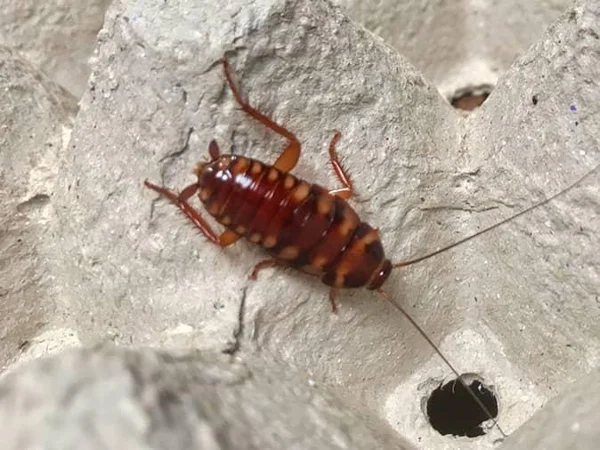According to the article, How Many Species of Cockroaches Plague Humanity? published on smithsonianmag.com, there are 4,500 species of roaches in the world but of that number, it is estimated that only 30 of those are considered pests. Unfortunately, the most common types of cockroaches found in New Jersey homes and businesses are among that pestilent group. Read on to learn more about these disgusting and disease spreading pests and what to do if you find your house or building infested with roaches.
American cockroaches

What American cockroaches look like
Earning the distinction of being the largest of house-infesting roach, American cockroaches may grow over two-inches in length. They are usually reddish brown in color, have a yellowish figure eight pattern situated on the back of their heads, and have wings that allow them to travel short distances. Like all roaches, they have six legs, are oval in shape, and are equipped with antennae.
Where you’ll find these roaches
American cockroaches typically live outdoors. Unfortunately, they can and will move indoors. They prefer to hide out in warm, moist or humid environments but it should be noted that they can live in drier areas as long as they have access to water. Common places to find these bugs include kitchens, basements, and crawl spaces as well as sewers. Yes, these small, vile bugs will traipse through feces and whatever else sewers contain before entering New Jersey homes and businesses.
The health concerns associated with American cockroaches
Given what we just discussed, it should not come as a surprise that American roaches are filthy pests that are capable of spreading multiple strands of bacteria including salmonella and E.coli. Both types of bacteria have been associated with outbreaks that have resulted in food poisoning.
American roaches, or more specifically, the proteins in their saliva, urine and feces may triggers allergies and asthma attacks. Children are especially susceptible.
Brownbanded cockroaches

What brownbanded cockroaches look like
Brownbanded cockroaches grow to about ½ inch in length. They are brown roaches that have, as their name suggests, brown bands running across their bodies. As has been the case in the two roaches we’ve already examined, brownbanded roaches are oval in shape, have the same number of legs as the others, and have antennae adorning their heads. A bit different than the previously mentioned roaches, male brownbanded cockroaches have wings but females have undeveloped wings that prevent them from flying.
Where you’ll find brownbanded roaches
Brownbanded cockroaches are typically found in areas where the temperature exceeds 80 degrees Fahrenheit and where it is drier. In kitchens and bathrooms, you may find them upper cabinets and shelving and even lurking near ceilings. They are also known to hide behind light switches, inside furniture and electronic equipment. They tend to avoid water and bright light.
The health concerns associated with brownbanded cockroaches
According to the PennState Extension website, brownbanded cockroaches carry bacteria and protozoa on their legs and bodies that can cause such issues as gastroenteritis and diarrhea.
German cockroaches

What German roaches look like
German cockroaches grow up to 5/8” long, are light brown to tan in coloring, and have two dark, practically parallel stripes on their backs. Like American roaches, German roaches have six legs, are oval-shaped, and have antennae. Though they have wings and are capable of flight, German cockroaches have a preference for running.
Where you’ll find these cockroaches
German cockroaches are fond of warm, humid environments and are often found in kitchens and bathrooms as well as in areas where food and drinks are consumed or made. They are frequently encountered and/or reported in commercial facilities that have kitchens or where food is handled or prepared including, but not limited to restaurants, healthcare buildings, and food processing facilities.
The health concerns associated with German cockroaches
Contracting Salmonella and E. coli, or developing staphylococcus infections are just a few of the health risks associated with German roaches. These pests are also capable of spreading parasitic worms and German cockroach allergens can cause allergic reaction or make asthma attacks worse, especially in children.
Oriental cockroaches

What Oriental cockroaches look like
About an inch in length, these roaches have shiny black to dark, reddish-brown coloring. And yes, they are oval-shaped, are endowed with six legs, and sport antennae just like the others. While male Oriental cockroaches have wings, females of this species have none. Neither can fly.
Where you’ll find Oriental cockroaches
Oriental cockroaches prefer cool, damp, and dark spaces. With that in mind, it shouldn’t come as a surprise to find them in crawl spaces or basements/cellars. They’re also frequently discovered under kitchen sinks, washing machines, and other appliances.
The health concerns associated with Oriental roaches
Food poisoning, dysentery, and diarrhea are health issues often attributed to Oriental cockroaches as they carry organisms on their legs and bodies that contaminate food as well as utensils and equipment needed to prepare food.
As is the case with other roaches mentioned, people may exhibit an allergic reaction when exposed to these bugs.
Another type of roach in New Jersey worth mentioning
The Pennsylvania wood cockroach is another type of cockroach that we encounter here in the garden state and while they are not nearly as worrisome as the others highlighted in this article, we found it best to include them.
Male Pennsylvania wood cockroaches may grow to over an inch in length while the ladies typically range in size between ½ and 3/4of an inch in length. They are dark brown in color and have wings whose front portions are outlined in whitish-yellow. Speaking of wings, male of this species has fully developed wings and are capable of flight. Females do not have developed wings rendering them incapable of flying.
These roaches are primarily found outside in wooded areas and do not traverse sewers like others do. Because of this and the fact that they cannot breed indoors, Pennsylvania wood roaches are not considered a significant threat. That said, there is a risk of food contamination of these bugs infiltrate structures.
Cockroach prevention tips
In order to eliminate the threat of cockroaches in your home or facility, we recommend the following cockroach prevention tips:
Seal off potential entry points
Avoid cockroach infestations by sealing or fixing any potential opening that these bugs can fit through. This includes gaps around doors and window, cracks in exterior walls and the foundation, torn window and door screens, and weatherstripping that is not doing its job.
Clean, clean, clean
As you can see, we cannot emphasize enough the importance of cleaning and sanitizing your space. Whether residential or commercial, it is imperative to clean up crumbs and spills, wash dishes, disinfect all surfaces, and remove trash often. Never let dirty dishes remain in the sink overnight or leave overflowing trash cans as is.
Eliminate moisture
Fixing leaking pipes or appliances, running dehumidifiers, and correcting moisture issues is also essential in the fight against roaches.
Get rid of clutter
Don’t make it easy for roaches to live undisturbed in your home or facility. Decluttering eliminates potential harborages of roaches and other insects and rodents for that matter.
How to get rid of cockroaches
In order to solve your cockroach problem, it is best to contact a local pest control company that specializes in cockroach control. At Arrow Pest Control, we’ve been exterminating cockroaches in home and businesses since the early 70s and have the tools, knowledge, and experience to accurately identify what type of cockroach has infested your structure, where they’re hiding, and what’s attracting them. Based on a FREE pest evaluation completed by a licensed pest control professional we will explain our findings and outline a plan of action that will get rid of roaches!
Providing pest control in Brick, Long Hill, Freehold, and Jersey City as well as communities throughout Essex, Hudson, Mercer, Middlesex, Monmouth, Morris, Ocean and Somerset counties, our locally owned and family-operated pest control company is ready to help you eliminate and prevent cockroach infestations that threaten health and safety.
Home Protection Program
Service consists of the elimination of your current pest or rodent problem, complemented by both interior and exterior year-round protection of your home, which is inclusive of three seasonal visits. The program covers your entire property including attics, mailboxes, playsets, sheds, and fences.
Pests targeted with Arrow’s Home Protection Plan services include ants (excluding carpenter ants, pharaoh ants and acrobatic), bees, boxelder bugs, carpenter bees, carpet beetles, centipedes, cicada killers, clover mites, crickets, digger bees, earwigs, fabric & paper pests, fleas (inside only), ground beetles, hornets, mice, pillbugs, millipedes, rats, roaches, silverfish, sowbugs, spiders, springtails, stored product pests, and wasps.
*If you have a pool house that requires service, pricing would increase based upon the size of the structure.

Free Home Estimate
"*" indicates required fields

